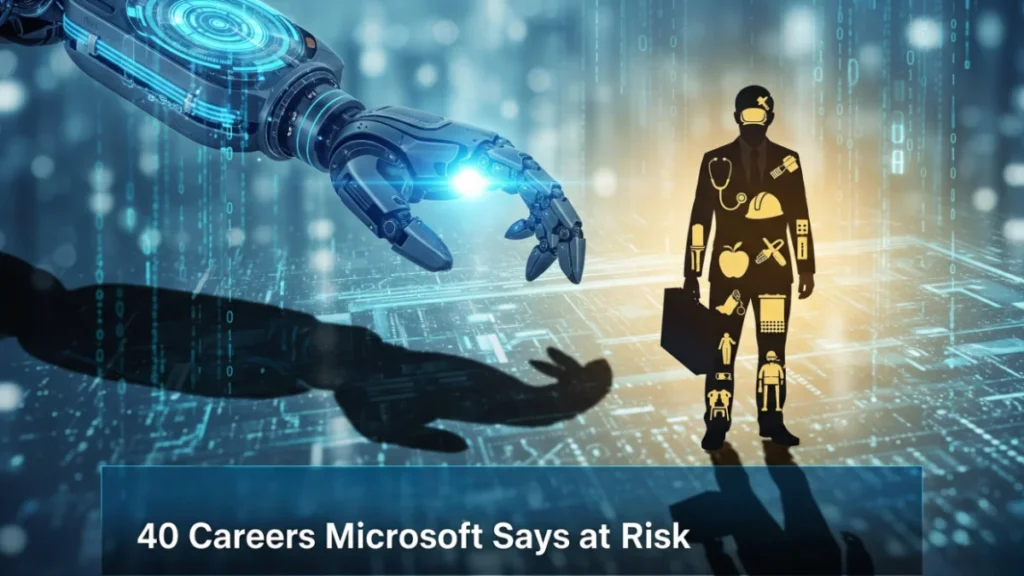A Microsoft study just shook up everything we thought we knew about job security. It says even “safe” professions like teaching and writing are at high risk of AI disruption. Forget blue-collar jobs—this report targets the office, and the future of knowledge work may never look the same.
Key Takeaways:
- Microsoft names 40 jobs most exposed to AI, including educators, translators, and sales reps.
- College degrees no longer shield you from AI disruption.
- Hands-on jobs like dredge operators and water treatment workers remain safer—at least for now.
- AI’s influence is growing across all sectors, even reshaping the education industry.
- Gen Z’s bet on “safe” career paths may not be future-proof after all.
Microsoft’s AI Warning: These 40 Jobs Are Most at Risk
For years, we’ve been told that AI will take over repetitive office tasks and low-skill jobs—but a groundbreaking new report from Microsoft flips that script. The tech giant’s researchers have released a list of 40 jobs most susceptible to being overtaken by generative AI—and surprisingly, many of them require college degrees.
From translators and historians to customer service reps and writers, the report makes it clear: AI isn’t just coming for the mundane—it’s coming for the educated.

The Shocking Truth: No Degree Is Safe
One of the most alarming revelations? A bachelor’s degree is no longer a safety net. The data, which analyzed 200,000 real-world Microsoft Copilot user interactions, found that jobs requiring a college education often have higher AI applicability than those that don’t. Roles such as political scientists, management analysts, journalists, and even business teachers are all on the chopping block.
“We find higher AI applicability for occupations requiring a Bachelor’s degree,” the researchers concluded.
This means that Gen Z, which is currently betting big on education in hopes of stable careers, might be entering a job market that’s shifting under their feet.
AI’s Grip on White-Collar Jobs
The Microsoft study highlights a massive shift in vulnerability, with knowledge-based work now squarely in AI’s crosshairs. Jobs involving information processing, communication, and coordination—the bread and butter of office life—are all seeing heavy AI encroachment.
Among the top 10 most affected roles:
- Interpreters and Translators
- Historians
- Sales Reps
- Writers and Authors
- Customer Service Representatives
- CNC Tool Programmers
- Telephone Operators
- Ticket Agents and Travel Clerks
- Broadcast Announcers and Radio DJs
- Brokerage Clerks
- Farm and Home Management Educators
- Telemarketers
- Concierges
- Political Scientists
- News Analysts, Reporters, and Journalists
- Mathematicians
- Technical Writers
- Proofreaders and Copy Markers
- Hosts and Hostesses
- Editors
- Business Teachers, Postsecondary
- Public Relations Specialists
- Demonstrators and Product Promoters
- Advertising Sales Agents
- New Accounts Clerks
- Statistical Assistants
- Counter and Rental Clerks
- Data Scientists
- Personal Financial Advisors
- Archivists
- Economics Teachers, Postsecondary
- Web Developers
- Management Analysts
- Geographers
- Models
- Market Research Analysts
- Public Safety Telecommunicators
- Switchboard Operators
- Library Science Teachers, Postsecondary
These aren’t just any jobs. Many are core components of business and academia, the very fields people have long believed to be immune to automation.
Teaching in the AI Crosshairs
For decades, teaching was seen as a “safe” profession—immune to automation because of its human-centric nature. But Microsoft’s report includes several education-related jobs among those highly exposed to AI, such as:
- Farm and home management educators
- Postsecondary business and economics teachers
- Library science instructors
Though full AI-teachers might not be rolling out tomorrow, the writing’s on the (digital) wall: AI-assisted instruction is no longer futuristic—it’s becoming part of the system.

Who’s Safe for Now?
There are still some career paths AI struggles with, mostly because they involve physical labor, unique equipment, or unpredictable environments. Think:
- Dredge operators
- Bridge and lock tenders
- Water treatment system operators
- Foundry Mold and Coremakers
- Rail-Track Laying and Maintenance Equipment Operators
- Pile Driver Operators
- Floor Sanders and Finishers
- Orderlies
- Motorboat Operators
- Logging Equipment Operators
These jobs require hands-on human skill, which today’s AI simply can’t replicate.
Still, as Nvidia CEO Jensen Huang pointed out:
“You’re not going to lose your job to an AI, but you’re going to lose your job to someone who uses AI.”
In other words, embracing AI isn’t optional anymore—it’s survival.
Why This Matters More Than Ever
As major companies like Amazon publicly announce AI-driven job cuts, the average worker is left wondering: Am I next?
Microsoft’s list doesn’t just show which jobs are vulnerable—it shows how deeply integrated AI already is in the workforce. It’s not a question of “if” anymore, but “how fast”.
Meanwhile, the healthcare sector, especially home health and personal care aides, appears to be a rare bright spot—low AI exposure, high growth.
Conclusion: Adapt or Risk Being Left Behind
This report should be a wake-up call. Jobs are evolving—fast. College degrees, experience, even creativity may not be enough protection anymore.
So what can you do?
✅ Learn to use AI tools—they’re becoming essential job companions
✅ Build hybrid skills (tech + human-centric work)
✅ Stay adaptable—the job you trained for might not exist in 5 years
The only constant now? Change.
Source link: Fortune
